Independent Living: Assessing Technology in Health and Social Care
VerifiedAdded on 2024/06/10
|22
|4510
|153
Report
AI Summary
This report comprehensively examines the role of technology in supporting independent living within health and social care (HSC). It defines independent living and assesses technology's contribution, highlighting advantages and hurdles in its application. The report addresses health and safety and ethical considerations, along with the impact of recent technological advancements on care workers, organizations, and social care services. Specific individual needs are considered, and the use of technology for HSC service users is evaluated using case studies. The report identifies barriers to technology adoption, such as training, maintenance costs, and technical breakdowns, and emphasizes the benefits, including increased autonomy, reduced risk, access to information, and improved accuracy. Ethical considerations like non-maleficence, beneficence, trustworthiness, and justice are discussed, alongside the impact of emerging technologies like remote diagnostics and improved communication tools on healthcare professionals and patient care.
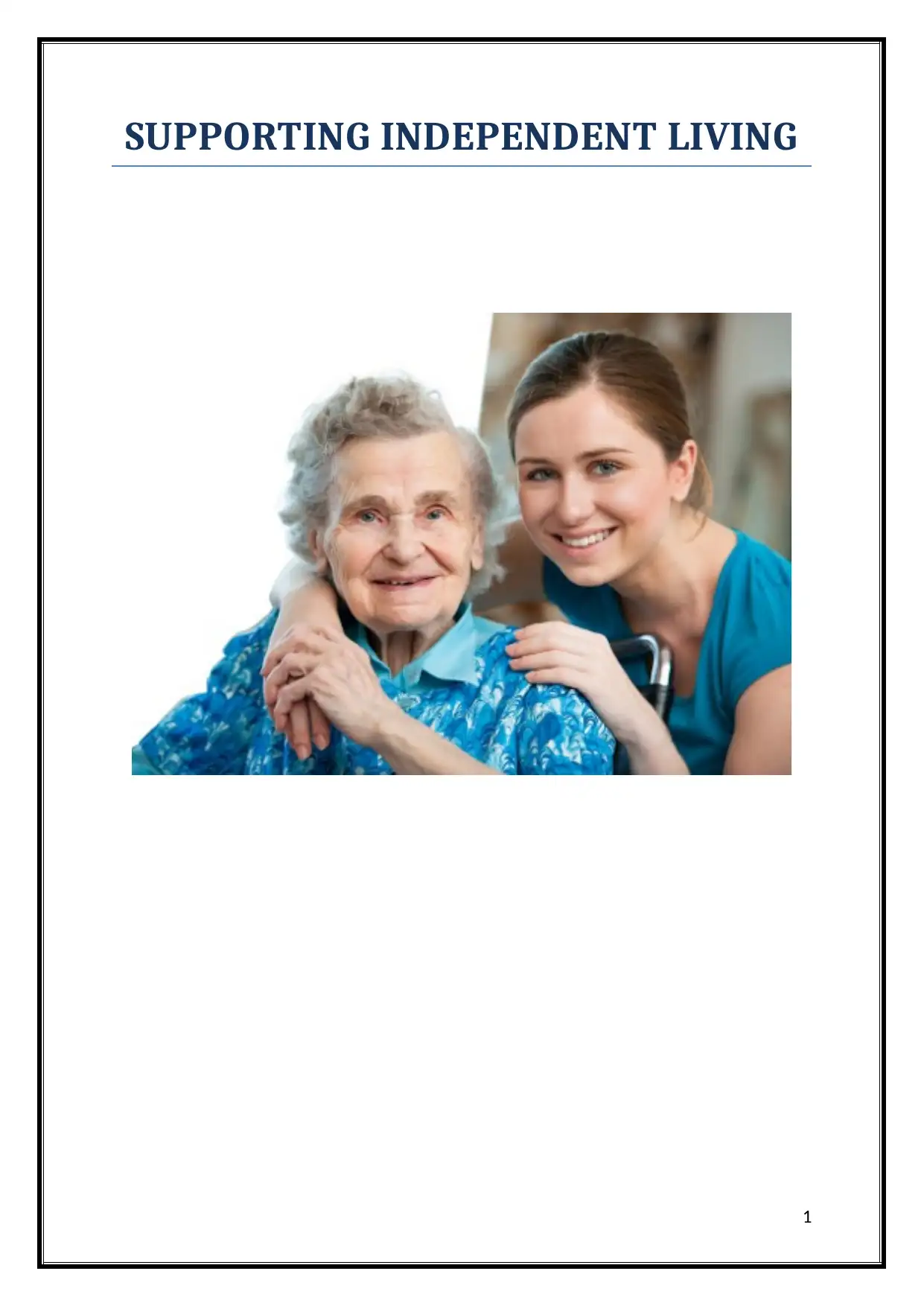
SUPPORTING INDEPENDENT LIVING
1
1
Paraphrase This Document
Need a fresh take? Get an instant paraphrase of this document with our AI Paraphraser
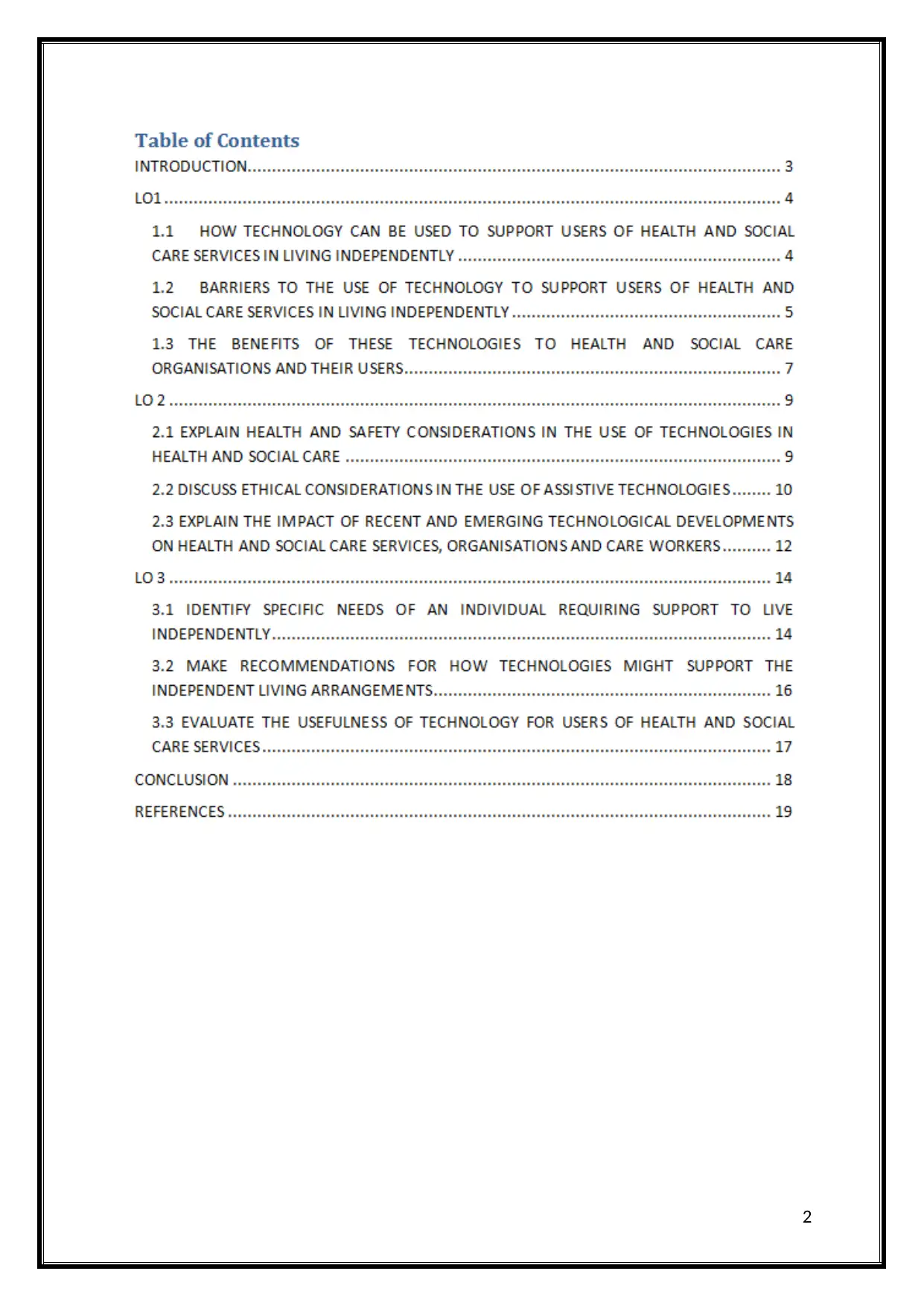
2
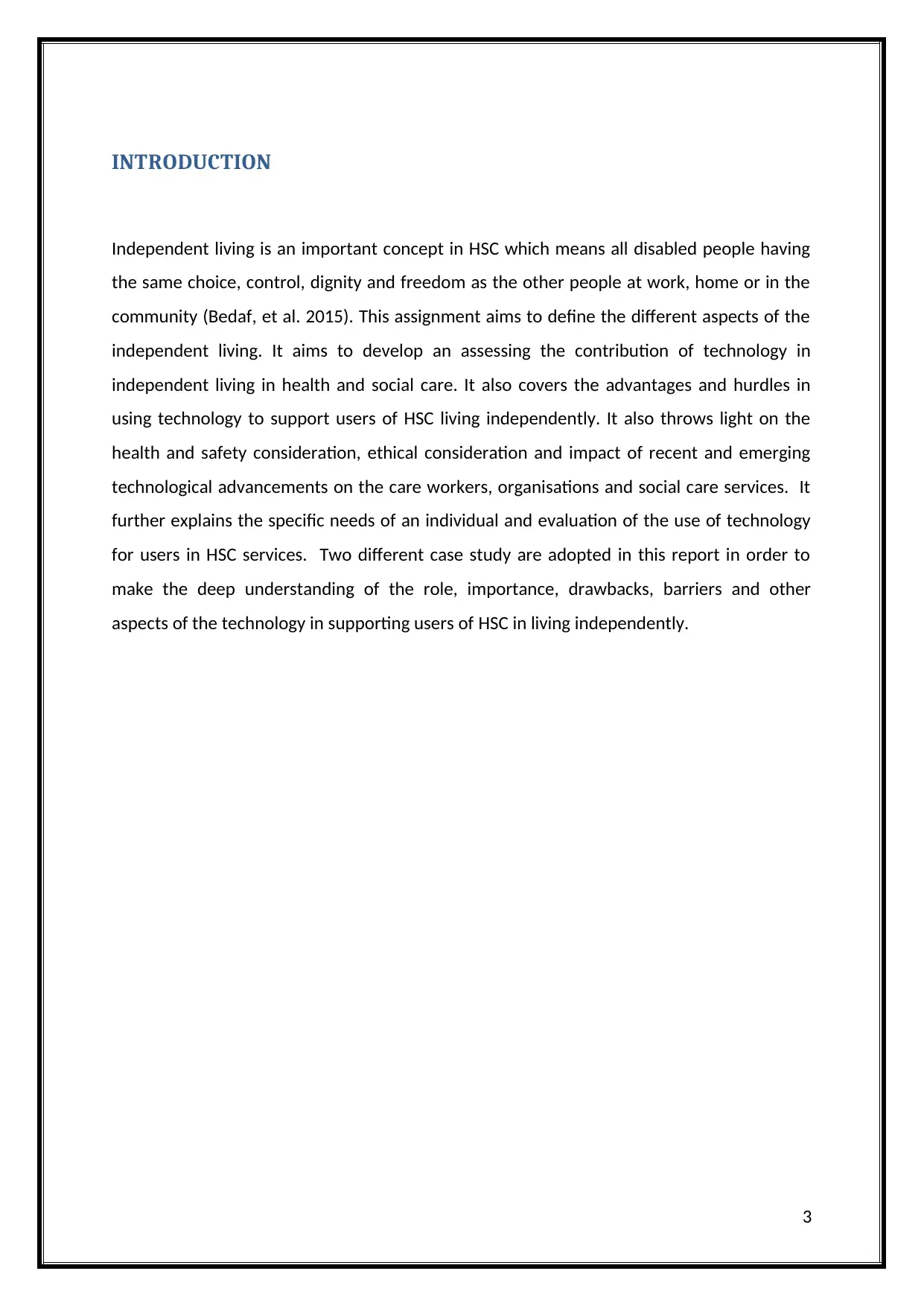
INTRODUCTION
Independent living is an important concept in HSC which means all disabled people having
the same choice, control, dignity and freedom as the other people at work, home or in the
community (Bedaf, et al. 2015). This assignment aims to define the different aspects of the
independent living. It aims to develop an assessing the contribution of technology in
independent living in health and social care. It also covers the advantages and hurdles in
using technology to support users of HSC living independently. It also throws light on the
health and safety consideration, ethical consideration and impact of recent and emerging
technological advancements on the care workers, organisations and social care services. It
further explains the specific needs of an individual and evaluation of the use of technology
for users in HSC services. Two different case study are adopted in this report in order to
make the deep understanding of the role, importance, drawbacks, barriers and other
aspects of the technology in supporting users of HSC in living independently.
3
Independent living is an important concept in HSC which means all disabled people having
the same choice, control, dignity and freedom as the other people at work, home or in the
community (Bedaf, et al. 2015). This assignment aims to define the different aspects of the
independent living. It aims to develop an assessing the contribution of technology in
independent living in health and social care. It also covers the advantages and hurdles in
using technology to support users of HSC living independently. It also throws light on the
health and safety consideration, ethical consideration and impact of recent and emerging
technological advancements on the care workers, organisations and social care services. It
further explains the specific needs of an individual and evaluation of the use of technology
for users in HSC services. Two different case study are adopted in this report in order to
make the deep understanding of the role, importance, drawbacks, barriers and other
aspects of the technology in supporting users of HSC in living independently.
3
⊘ This is a preview!⊘
Do you want full access?
Subscribe today to unlock all pages.

Trusted by 1+ million students worldwide
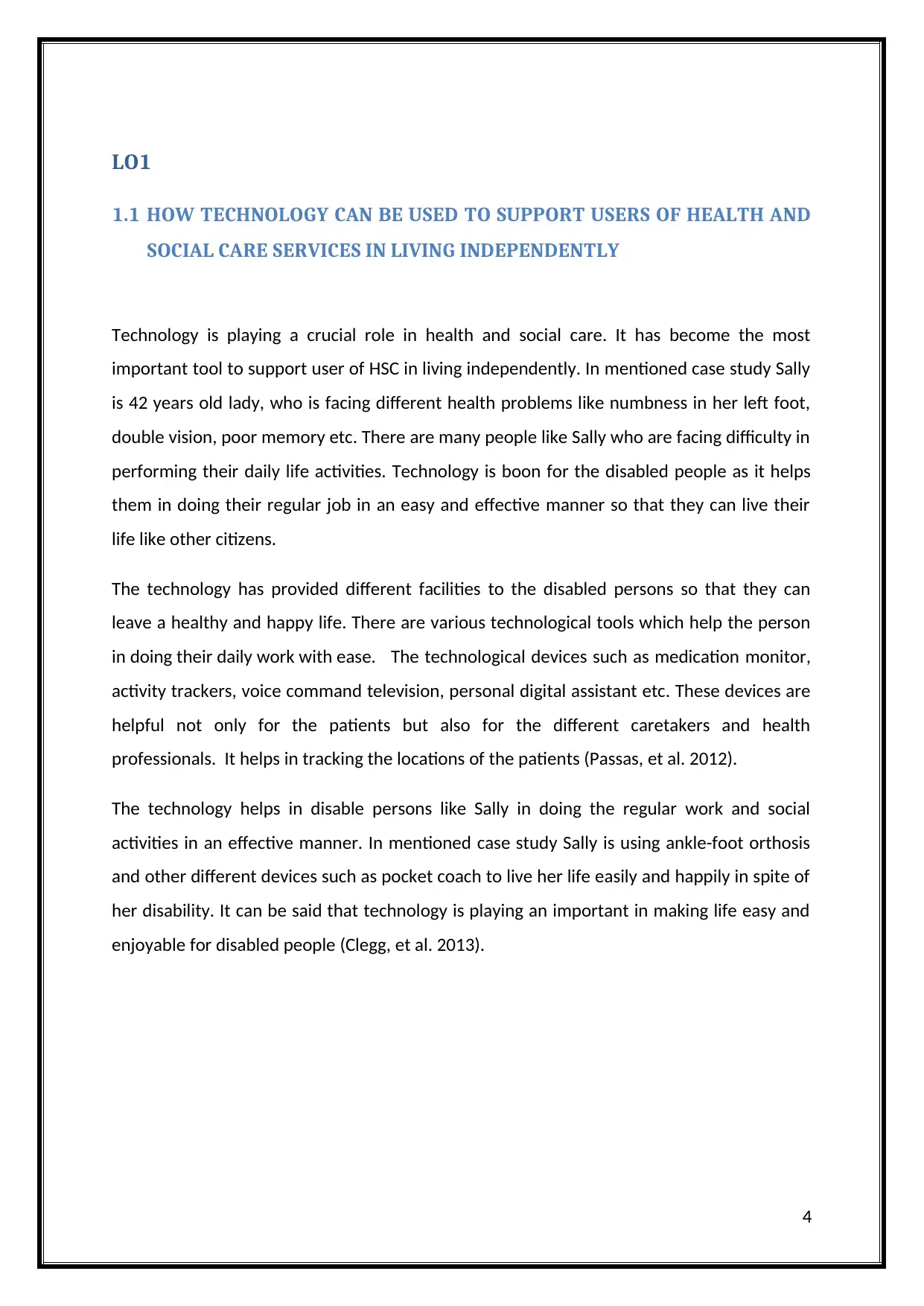
LO1
1.1 HOW TECHNOLOGY CAN BE USED TO SUPPORT USERS OF HEALTH AND
SOCIAL CARE SERVICES IN LIVING INDEPENDENTLY
Technology is playing a crucial role in health and social care. It has become the most
important tool to support user of HSC in living independently. In mentioned case study Sally
is 42 years old lady, who is facing different health problems like numbness in her left foot,
double vision, poor memory etc. There are many people like Sally who are facing difficulty in
performing their daily life activities. Technology is boon for the disabled people as it helps
them in doing their regular job in an easy and effective manner so that they can live their
life like other citizens.
The technology has provided different facilities to the disabled persons so that they can
leave a healthy and happy life. There are various technological tools which help the person
in doing their daily work with ease. The technological devices such as medication monitor,
activity trackers, voice command television, personal digital assistant etc. These devices are
helpful not only for the patients but also for the different caretakers and health
professionals. It helps in tracking the locations of the patients (Passas, et al. 2012).
The technology helps in disable persons like Sally in doing the regular work and social
activities in an effective manner. In mentioned case study Sally is using ankle-foot orthosis
and other different devices such as pocket coach to live her life easily and happily in spite of
her disability. It can be said that technology is playing an important in making life easy and
enjoyable for disabled people (Clegg, et al. 2013).
4
1.1 HOW TECHNOLOGY CAN BE USED TO SUPPORT USERS OF HEALTH AND
SOCIAL CARE SERVICES IN LIVING INDEPENDENTLY
Technology is playing a crucial role in health and social care. It has become the most
important tool to support user of HSC in living independently. In mentioned case study Sally
is 42 years old lady, who is facing different health problems like numbness in her left foot,
double vision, poor memory etc. There are many people like Sally who are facing difficulty in
performing their daily life activities. Technology is boon for the disabled people as it helps
them in doing their regular job in an easy and effective manner so that they can live their
life like other citizens.
The technology has provided different facilities to the disabled persons so that they can
leave a healthy and happy life. There are various technological tools which help the person
in doing their daily work with ease. The technological devices such as medication monitor,
activity trackers, voice command television, personal digital assistant etc. These devices are
helpful not only for the patients but also for the different caretakers and health
professionals. It helps in tracking the locations of the patients (Passas, et al. 2012).
The technology helps in disable persons like Sally in doing the regular work and social
activities in an effective manner. In mentioned case study Sally is using ankle-foot orthosis
and other different devices such as pocket coach to live her life easily and happily in spite of
her disability. It can be said that technology is playing an important in making life easy and
enjoyable for disabled people (Clegg, et al. 2013).
4
Paraphrase This Document
Need a fresh take? Get an instant paraphrase of this document with our AI Paraphraser
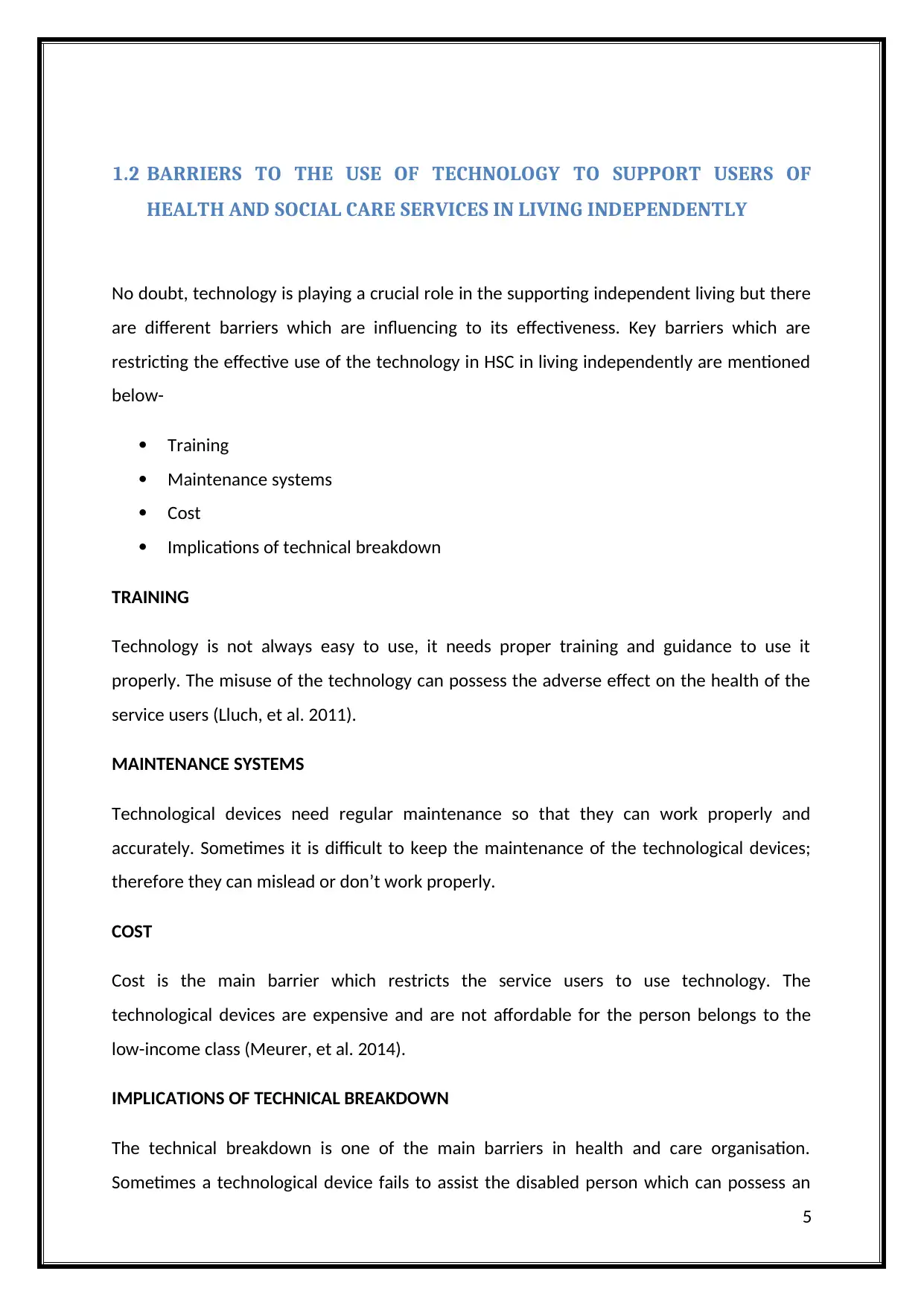
1.2 BARRIERS TO THE USE OF TECHNOLOGY TO SUPPORT USERS OF
HEALTH AND SOCIAL CARE SERVICES IN LIVING INDEPENDENTLY
No doubt, technology is playing a crucial role in the supporting independent living but there
are different barriers which are influencing to its effectiveness. Key barriers which are
restricting the effective use of the technology in HSC in living independently are mentioned
below-
Training
Maintenance systems
Cost
Implications of technical breakdown
TRAINING
Technology is not always easy to use, it needs proper training and guidance to use it
properly. The misuse of the technology can possess the adverse effect on the health of the
service users (Lluch, et al. 2011).
MAINTENANCE SYSTEMS
Technological devices need regular maintenance so that they can work properly and
accurately. Sometimes it is difficult to keep the maintenance of the technological devices;
therefore they can mislead or don’t work properly.
COST
Cost is the main barrier which restricts the service users to use technology. The
technological devices are expensive and are not affordable for the person belongs to the
low-income class (Meurer, et al. 2014).
IMPLICATIONS OF TECHNICAL BREAKDOWN
The technical breakdown is one of the main barriers in health and care organisation.
Sometimes a technological device fails to assist the disabled person which can possess an
5
HEALTH AND SOCIAL CARE SERVICES IN LIVING INDEPENDENTLY
No doubt, technology is playing a crucial role in the supporting independent living but there
are different barriers which are influencing to its effectiveness. Key barriers which are
restricting the effective use of the technology in HSC in living independently are mentioned
below-
Training
Maintenance systems
Cost
Implications of technical breakdown
TRAINING
Technology is not always easy to use, it needs proper training and guidance to use it
properly. The misuse of the technology can possess the adverse effect on the health of the
service users (Lluch, et al. 2011).
MAINTENANCE SYSTEMS
Technological devices need regular maintenance so that they can work properly and
accurately. Sometimes it is difficult to keep the maintenance of the technological devices;
therefore they can mislead or don’t work properly.
COST
Cost is the main barrier which restricts the service users to use technology. The
technological devices are expensive and are not affordable for the person belongs to the
low-income class (Meurer, et al. 2014).
IMPLICATIONS OF TECHNICAL BREAKDOWN
The technical breakdown is one of the main barriers in health and care organisation.
Sometimes a technological device fails to assist the disabled person which can possess an
5
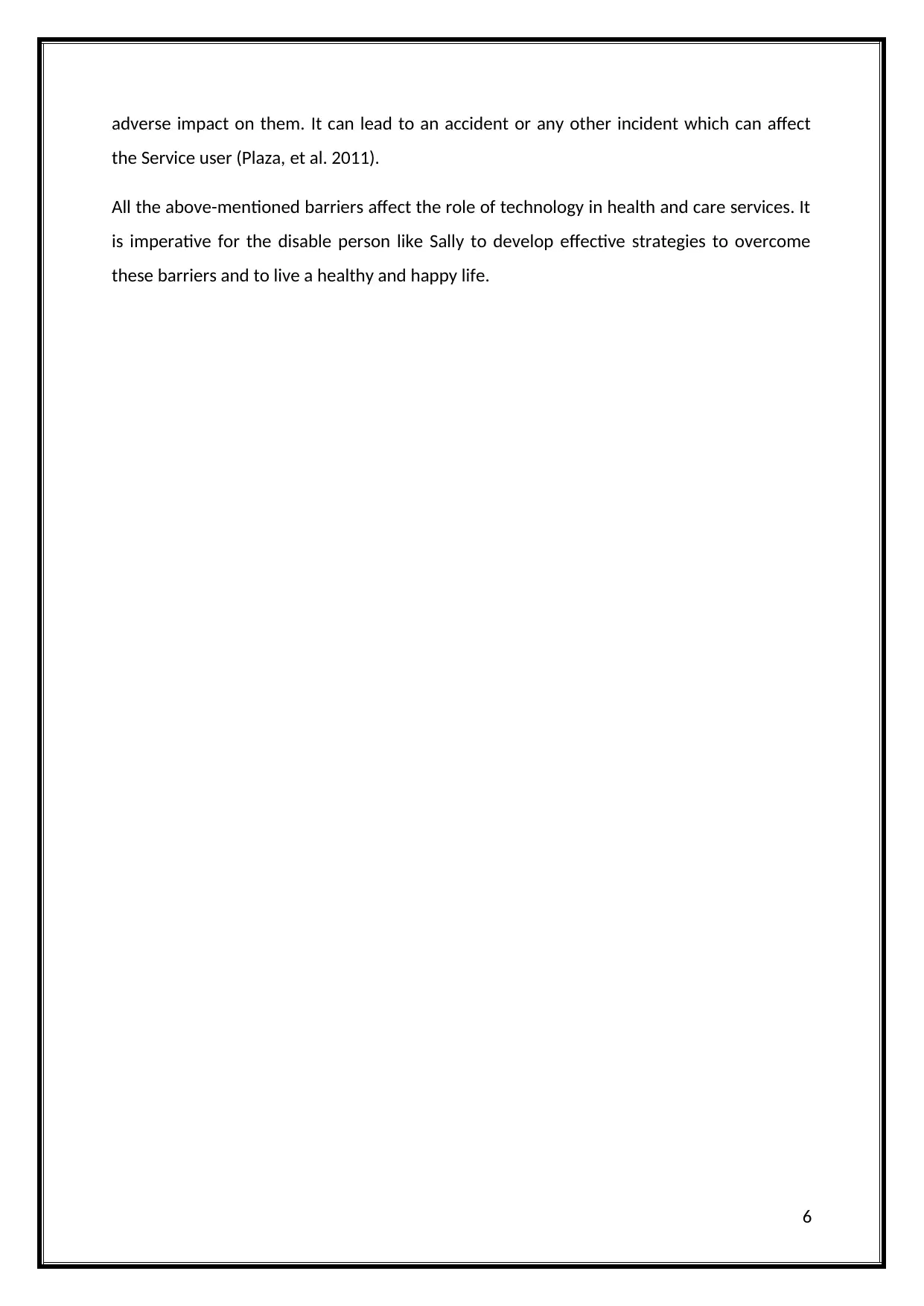
adverse impact on them. It can lead to an accident or any other incident which can affect
the Service user (Plaza, et al. 2011).
All the above-mentioned barriers affect the role of technology in health and care services. It
is imperative for the disable person like Sally to develop effective strategies to overcome
these barriers and to live a healthy and happy life.
6
the Service user (Plaza, et al. 2011).
All the above-mentioned barriers affect the role of technology in health and care services. It
is imperative for the disable person like Sally to develop effective strategies to overcome
these barriers and to live a healthy and happy life.
6
⊘ This is a preview!⊘
Do you want full access?
Subscribe today to unlock all pages.

Trusted by 1+ million students worldwide
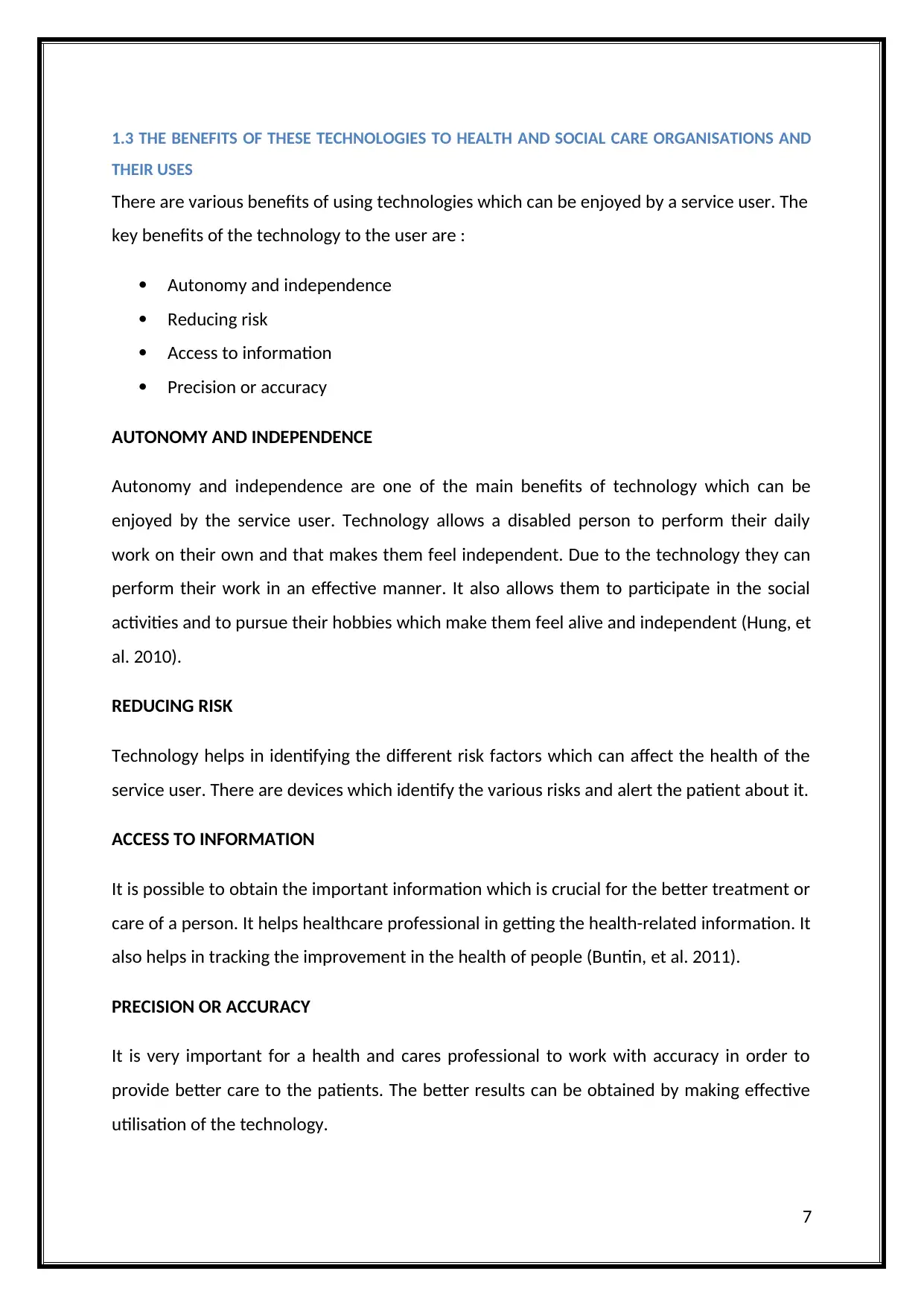
1.3 THE BENEFITS OF THESE TECHNOLOGIES TO HEALTH AND SOCIAL CARE ORGANISATIONS AND
THEIR USES
There are various benefits of using technologies which can be enjoyed by a service user. The
key benefits of the technology to the user are :
Autonomy and independence
Reducing risk
Access to information
Precision or accuracy
AUTONOMY AND INDEPENDENCE
Autonomy and independence are one of the main benefits of technology which can be
enjoyed by the service user. Technology allows a disabled person to perform their daily
work on their own and that makes them feel independent. Due to the technology they can
perform their work in an effective manner. It also allows them to participate in the social
activities and to pursue their hobbies which make them feel alive and independent (Hung, et
al. 2010).
REDUCING RISK
Technology helps in identifying the different risk factors which can affect the health of the
service user. There are devices which identify the various risks and alert the patient about it.
ACCESS TO INFORMATION
It is possible to obtain the important information which is crucial for the better treatment or
care of a person. It helps healthcare professional in getting the health-related information. It
also helps in tracking the improvement in the health of people (Buntin, et al. 2011).
PRECISION OR ACCURACY
It is very important for a health and cares professional to work with accuracy in order to
provide better care to the patients. The better results can be obtained by making effective
utilisation of the technology.
7
THEIR USES
There are various benefits of using technologies which can be enjoyed by a service user. The
key benefits of the technology to the user are :
Autonomy and independence
Reducing risk
Access to information
Precision or accuracy
AUTONOMY AND INDEPENDENCE
Autonomy and independence are one of the main benefits of technology which can be
enjoyed by the service user. Technology allows a disabled person to perform their daily
work on their own and that makes them feel independent. Due to the technology they can
perform their work in an effective manner. It also allows them to participate in the social
activities and to pursue their hobbies which make them feel alive and independent (Hung, et
al. 2010).
REDUCING RISK
Technology helps in identifying the different risk factors which can affect the health of the
service user. There are devices which identify the various risks and alert the patient about it.
ACCESS TO INFORMATION
It is possible to obtain the important information which is crucial for the better treatment or
care of a person. It helps healthcare professional in getting the health-related information. It
also helps in tracking the improvement in the health of people (Buntin, et al. 2011).
PRECISION OR ACCURACY
It is very important for a health and cares professional to work with accuracy in order to
provide better care to the patients. The better results can be obtained by making effective
utilisation of the technology.
7
Paraphrase This Document
Need a fresh take? Get an instant paraphrase of this document with our AI Paraphraser
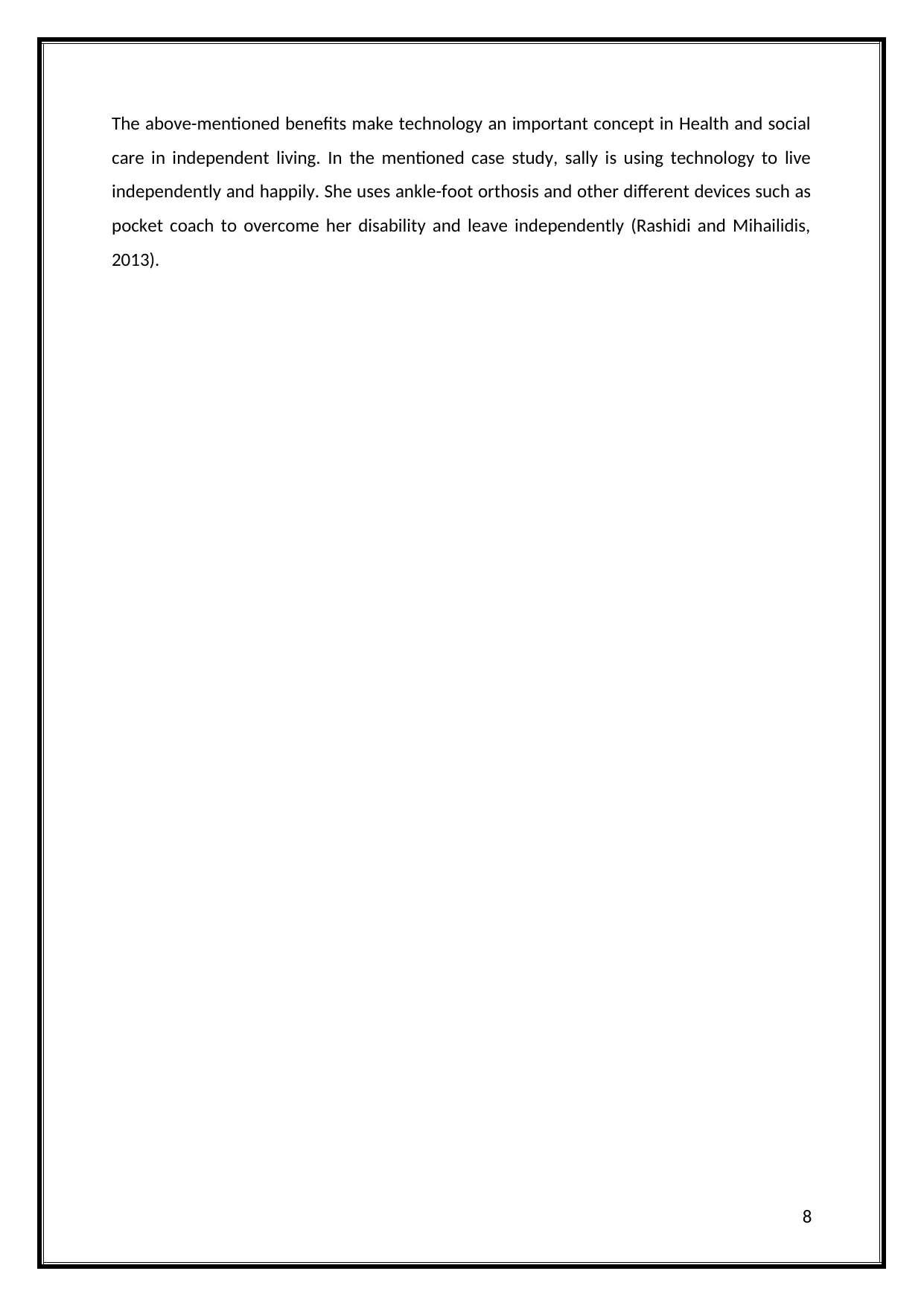
The above-mentioned benefits make technology an important concept in Health and social
care in independent living. In the mentioned case study, sally is using technology to live
independently and happily. She uses ankle-foot orthosis and other different devices such as
pocket coach to overcome her disability and leave independently (Rashidi and Mihailidis,
2013).
8
care in independent living. In the mentioned case study, sally is using technology to live
independently and happily. She uses ankle-foot orthosis and other different devices such as
pocket coach to overcome her disability and leave independently (Rashidi and Mihailidis,
2013).
8
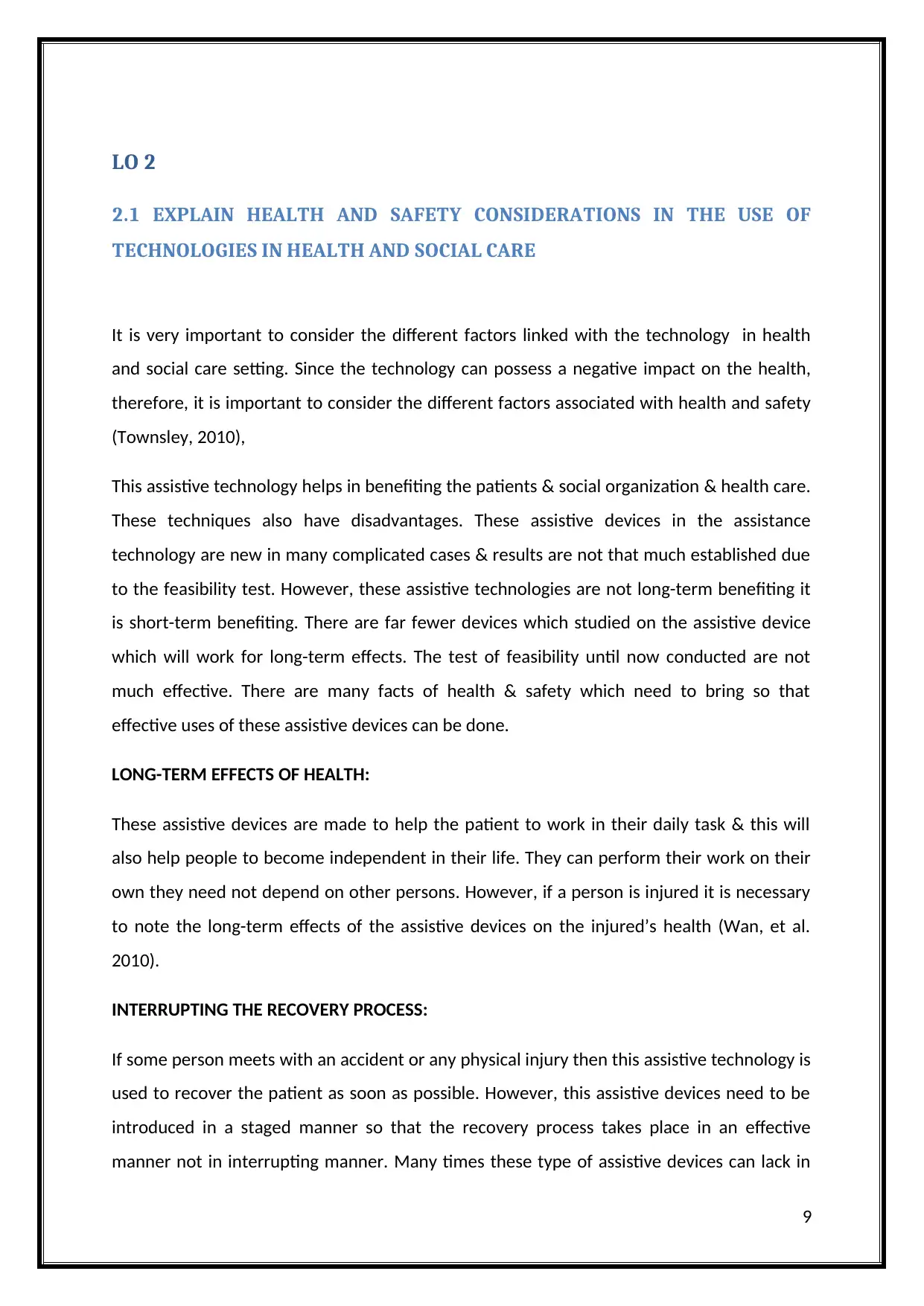
LO 2
2.1 EXPLAIN HEALTH AND SAFETY CONSIDERATIONS IN THE USE OF
TECHNOLOGIES IN HEALTH AND SOCIAL CARE
It is very important to consider the different factors linked with the technology in health
and social care setting. Since the technology can possess a negative impact on the health,
therefore, it is important to consider the different factors associated with health and safety
(Townsley, 2010),
This assistive technology helps in benefiting the patients & social organization & health care.
These techniques also have disadvantages. These assistive devices in the assistance
technology are new in many complicated cases & results are not that much established due
to the feasibility test. However, these assistive technologies are not long-term benefiting it
is short-term benefiting. There are far fewer devices which studied on the assistive device
which will work for long-term effects. The test of feasibility until now conducted are not
much effective. There are many facts of health & safety which need to bring so that
effective uses of these assistive devices can be done.
LONG-TERM EFFECTS OF HEALTH:
These assistive devices are made to help the patient to work in their daily task & this will
also help people to become independent in their life. They can perform their work on their
own they need not depend on other persons. However, if a person is injured it is necessary
to note the long-term effects of the assistive devices on the injured’s health (Wan, et al.
2010).
INTERRUPTING THE RECOVERY PROCESS:
If some person meets with an accident or any physical injury then this assistive technology is
used to recover the patient as soon as possible. However, this assistive devices need to be
introduced in a staged manner so that the recovery process takes place in an effective
manner not in interrupting manner. Many times these type of assistive devices can lack in
9
2.1 EXPLAIN HEALTH AND SAFETY CONSIDERATIONS IN THE USE OF
TECHNOLOGIES IN HEALTH AND SOCIAL CARE
It is very important to consider the different factors linked with the technology in health
and social care setting. Since the technology can possess a negative impact on the health,
therefore, it is important to consider the different factors associated with health and safety
(Townsley, 2010),
This assistive technology helps in benefiting the patients & social organization & health care.
These techniques also have disadvantages. These assistive devices in the assistance
technology are new in many complicated cases & results are not that much established due
to the feasibility test. However, these assistive technologies are not long-term benefiting it
is short-term benefiting. There are far fewer devices which studied on the assistive device
which will work for long-term effects. The test of feasibility until now conducted are not
much effective. There are many facts of health & safety which need to bring so that
effective uses of these assistive devices can be done.
LONG-TERM EFFECTS OF HEALTH:
These assistive devices are made to help the patient to work in their daily task & this will
also help people to become independent in their life. They can perform their work on their
own they need not depend on other persons. However, if a person is injured it is necessary
to note the long-term effects of the assistive devices on the injured’s health (Wan, et al.
2010).
INTERRUPTING THE RECOVERY PROCESS:
If some person meets with an accident or any physical injury then this assistive technology is
used to recover the patient as soon as possible. However, this assistive devices need to be
introduced in a staged manner so that the recovery process takes place in an effective
manner not in interrupting manner. Many times these type of assistive devices can lack in
9
⊘ This is a preview!⊘
Do you want full access?
Subscribe today to unlock all pages.

Trusted by 1+ million students worldwide
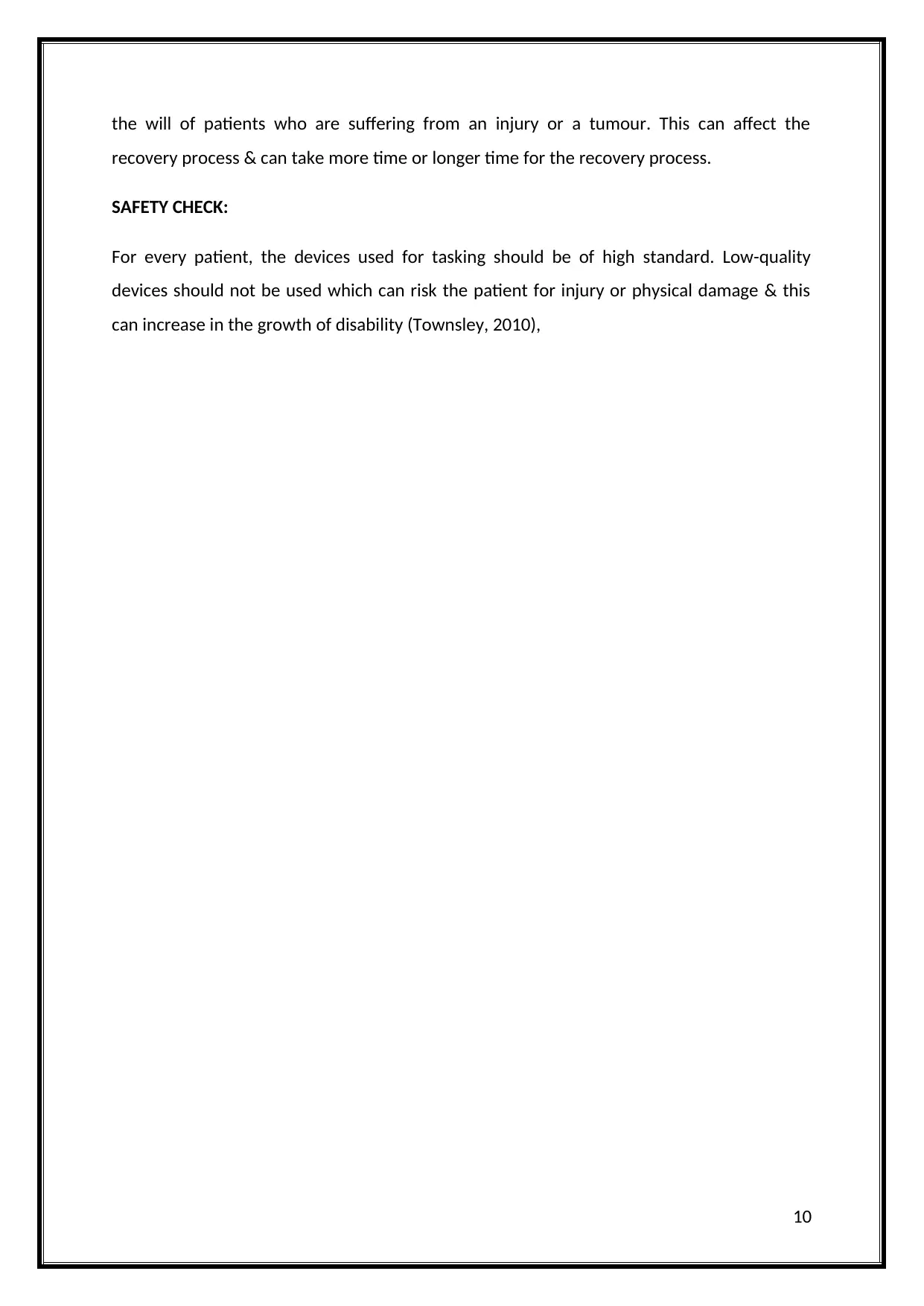
the will of patients who are suffering from an injury or a tumour. This can affect the
recovery process & can take more time or longer time for the recovery process.
SAFETY CHECK:
For every patient, the devices used for tasking should be of high standard. Low-quality
devices should not be used which can risk the patient for injury or physical damage & this
can increase in the growth of disability (Townsley, 2010),
10
recovery process & can take more time or longer time for the recovery process.
SAFETY CHECK:
For every patient, the devices used for tasking should be of high standard. Low-quality
devices should not be used which can risk the patient for injury or physical damage & this
can increase in the growth of disability (Townsley, 2010),
10
Paraphrase This Document
Need a fresh take? Get an instant paraphrase of this document with our AI Paraphraser
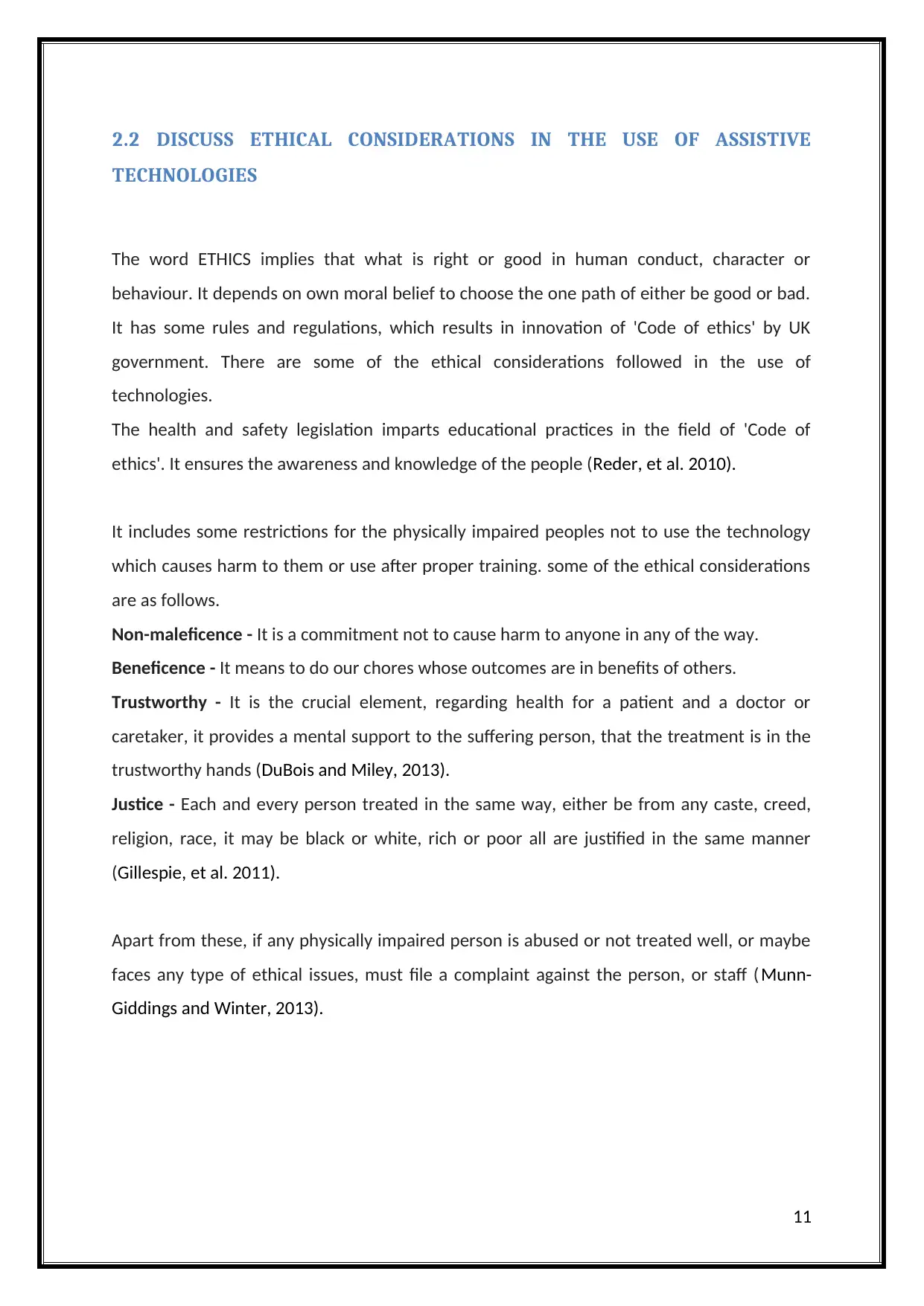
2.2 DISCUSS ETHICAL CONSIDERATIONS IN THE USE OF ASSISTIVE
TECHNOLOGIES
The word ETHICS implies that what is right or good in human conduct, character or
behaviour. It depends on own moral belief to choose the one path of either be good or bad.
It has some rules and regulations, which results in innovation of 'Code of ethics' by UK
government. There are some of the ethical considerations followed in the use of
technologies.
The health and safety legislation imparts educational practices in the field of 'Code of
ethics'. It ensures the awareness and knowledge of the people (Reder, et al. 2010).
It includes some restrictions for the physically impaired peoples not to use the technology
which causes harm to them or use after proper training. some of the ethical considerations
are as follows.
Non-maleficence - It is a commitment not to cause harm to anyone in any of the way.
Beneficence - It means to do our chores whose outcomes are in benefits of others.
Trustworthy - It is the crucial element, regarding health for a patient and a doctor or
caretaker, it provides a mental support to the suffering person, that the treatment is in the
trustworthy hands (DuBois and Miley, 2013).
Justice - Each and every person treated in the same way, either be from any caste, creed,
religion, race, it may be black or white, rich or poor all are justified in the same manner
(Gillespie, et al. 2011).
Apart from these, if any physically impaired person is abused or not treated well, or maybe
faces any type of ethical issues, must file a complaint against the person, or staff (Munn-
Giddings and Winter, 2013).
11
TECHNOLOGIES
The word ETHICS implies that what is right or good in human conduct, character or
behaviour. It depends on own moral belief to choose the one path of either be good or bad.
It has some rules and regulations, which results in innovation of 'Code of ethics' by UK
government. There are some of the ethical considerations followed in the use of
technologies.
The health and safety legislation imparts educational practices in the field of 'Code of
ethics'. It ensures the awareness and knowledge of the people (Reder, et al. 2010).
It includes some restrictions for the physically impaired peoples not to use the technology
which causes harm to them or use after proper training. some of the ethical considerations
are as follows.
Non-maleficence - It is a commitment not to cause harm to anyone in any of the way.
Beneficence - It means to do our chores whose outcomes are in benefits of others.
Trustworthy - It is the crucial element, regarding health for a patient and a doctor or
caretaker, it provides a mental support to the suffering person, that the treatment is in the
trustworthy hands (DuBois and Miley, 2013).
Justice - Each and every person treated in the same way, either be from any caste, creed,
religion, race, it may be black or white, rich or poor all are justified in the same manner
(Gillespie, et al. 2011).
Apart from these, if any physically impaired person is abused or not treated well, or maybe
faces any type of ethical issues, must file a complaint against the person, or staff (Munn-
Giddings and Winter, 2013).
11
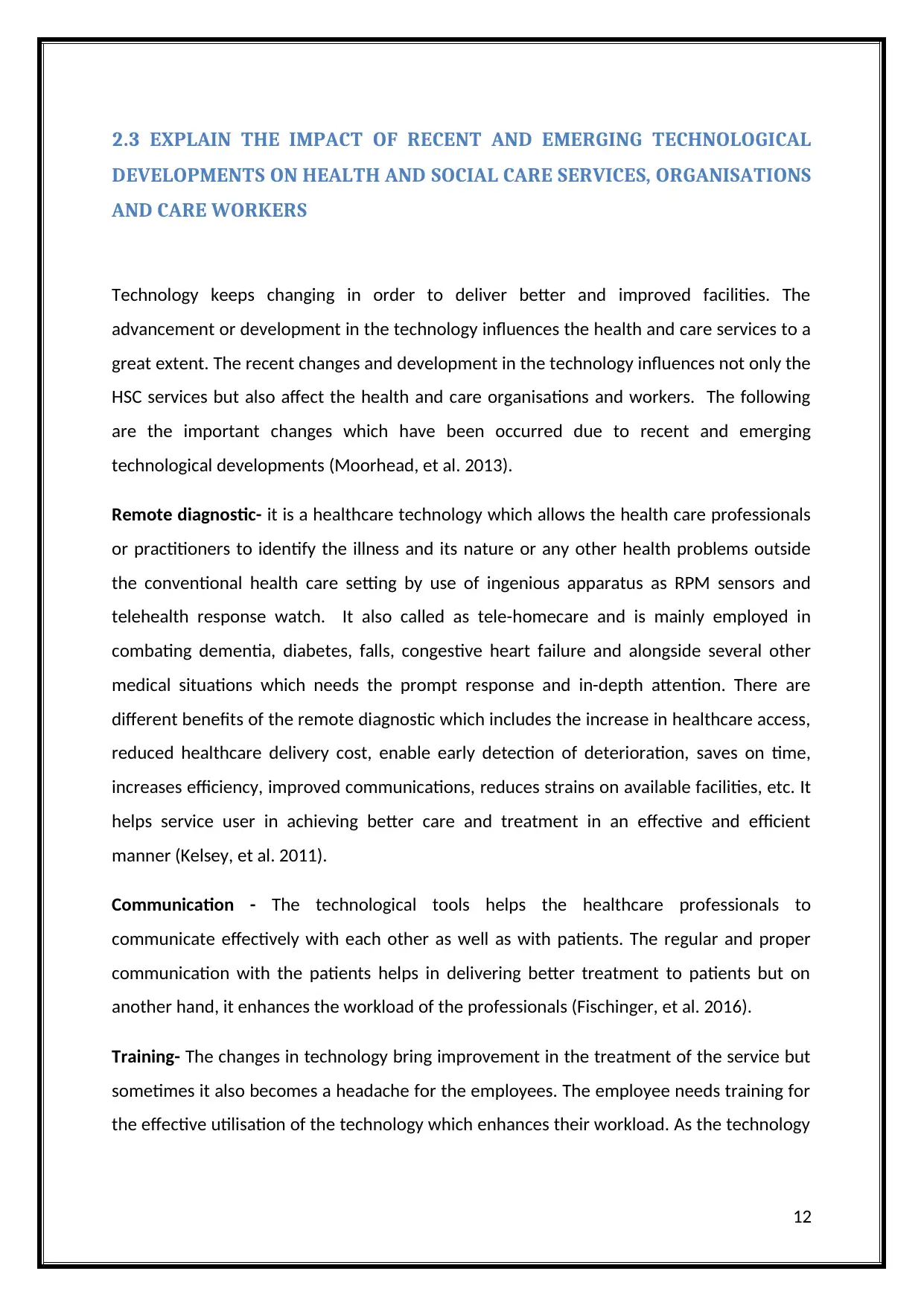
2.3 EXPLAIN THE IMPACT OF RECENT AND EMERGING TECHNOLOGICAL
DEVELOPMENTS ON HEALTH AND SOCIAL CARE SERVICES, ORGANISATIONS
AND CARE WORKERS
Technology keeps changing in order to deliver better and improved facilities. The
advancement or development in the technology influences the health and care services to a
great extent. The recent changes and development in the technology influences not only the
HSC services but also affect the health and care organisations and workers. The following
are the important changes which have been occurred due to recent and emerging
technological developments (Moorhead, et al. 2013).
Remote diagnostic- it is a healthcare technology which allows the health care professionals
or practitioners to identify the illness and its nature or any other health problems outside
the conventional health care setting by use of ingenious apparatus as RPM sensors and
telehealth response watch. It also called as tele-homecare and is mainly employed in
combating dementia, diabetes, falls, congestive heart failure and alongside several other
medical situations which needs the prompt response and in-depth attention. There are
different benefits of the remote diagnostic which includes the increase in healthcare access,
reduced healthcare delivery cost, enable early detection of deterioration, saves on time,
increases efficiency, improved communications, reduces strains on available facilities, etc. It
helps service user in achieving better care and treatment in an effective and efficient
manner (Kelsey, et al. 2011).
Communication - The technological tools helps the healthcare professionals to
communicate effectively with each other as well as with patients. The regular and proper
communication with the patients helps in delivering better treatment to patients but on
another hand, it enhances the workload of the professionals (Fischinger, et al. 2016).
Training- The changes in technology bring improvement in the treatment of the service but
sometimes it also becomes a headache for the employees. The employee needs training for
the effective utilisation of the technology which enhances their workload. As the technology
12
DEVELOPMENTS ON HEALTH AND SOCIAL CARE SERVICES, ORGANISATIONS
AND CARE WORKERS
Technology keeps changing in order to deliver better and improved facilities. The
advancement or development in the technology influences the health and care services to a
great extent. The recent changes and development in the technology influences not only the
HSC services but also affect the health and care organisations and workers. The following
are the important changes which have been occurred due to recent and emerging
technological developments (Moorhead, et al. 2013).
Remote diagnostic- it is a healthcare technology which allows the health care professionals
or practitioners to identify the illness and its nature or any other health problems outside
the conventional health care setting by use of ingenious apparatus as RPM sensors and
telehealth response watch. It also called as tele-homecare and is mainly employed in
combating dementia, diabetes, falls, congestive heart failure and alongside several other
medical situations which needs the prompt response and in-depth attention. There are
different benefits of the remote diagnostic which includes the increase in healthcare access,
reduced healthcare delivery cost, enable early detection of deterioration, saves on time,
increases efficiency, improved communications, reduces strains on available facilities, etc. It
helps service user in achieving better care and treatment in an effective and efficient
manner (Kelsey, et al. 2011).
Communication - The technological tools helps the healthcare professionals to
communicate effectively with each other as well as with patients. The regular and proper
communication with the patients helps in delivering better treatment to patients but on
another hand, it enhances the workload of the professionals (Fischinger, et al. 2016).
Training- The changes in technology bring improvement in the treatment of the service but
sometimes it also becomes a headache for the employees. The employee needs training for
the effective utilisation of the technology which enhances their workload. As the technology
12
⊘ This is a preview!⊘
Do you want full access?
Subscribe today to unlock all pages.

Trusted by 1+ million students worldwide
1 out of 22
Related Documents
Your All-in-One AI-Powered Toolkit for Academic Success.
+13062052269
info@desklib.com
Available 24*7 on WhatsApp / Email
![[object Object]](/_next/static/media/star-bottom.7253800d.svg)
Unlock your academic potential
Copyright © 2020–2025 A2Z Services. All Rights Reserved. Developed and managed by ZUCOL.





